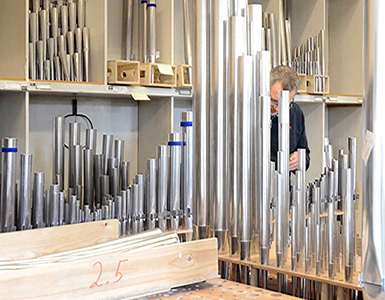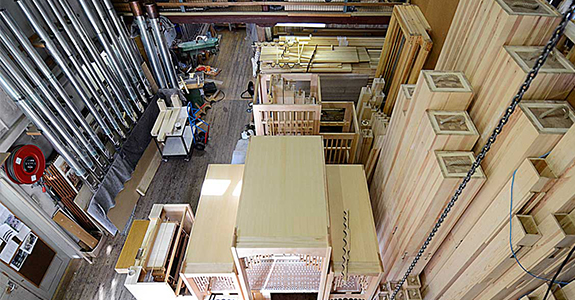New organs
At Marcussen & Søn, all professional skills are represented, and we are continually producing our own metal pipes and reeds in our workshops and foundry. Our employees each contribute with their special expertise during the manufacturing, all the way until the instrument has been installed at its destination.
The voicing shop
The planning of a new organ begins in the voicing shop, where the wind pressure and pipe dimensions (scales) are determined: Diameter of the pipe body, mouth width, mouth height, tip hole, beard or ears, material thickness and possibly a tuning slot. The scales are especially important for the tonal expression. They are planned individually for the building, the organ is meant for, considering the following: The acoustics, the size and shape of the building, as well as the expectations for sound and volume. The work of the voicer builds on the extensive tradition and versatile experience of the firm, a collection of scales from numerous previous organ projects, and the voicer’s own experience and intuition..

The drafting room
The planning continues in the drafting room, where a detailed drawing of the façade and arrangement of the organ is composed. During the planning of a new church organ, it is necessary to include advice from the authorities, e.g. the national heritage council, and the Ministry of Church Affairs’ organ consultant. In the drafting room, 3D drawings of the organ parts are composed in the dimensions 1:1. The 3D drawings ensure the quality and precision of each component, as they take shape in our workshops.

The joiner’s workshop
The manufacturing of organ cases, wind chests and consoles, components for the key and stop action, bellows, wooden pipes and reed pipes is performed by skilled organ builders according to the best artisan’s traditions, and almost all components are still made of solid wood. The organ builder use many select wood species, especially oak and Scandinavian pine, but also ebony, cedar and mahogany. Each species is meticulously chosen to meet the specific function of each particular organ component.
SEE AND HEAR AN EXAMPLE OF ONE OF OUR ORGANS
The sound of a Marcussen & Son organ is something special. Since our very beginning, the sound has been a central part of our hallmark – and so it remains. A pipe organ from Marcussen & Son is known by the sound. We are proud when we are told that music lovers clearly feel and hear the difference and know when it is a Marcussen & Son organ that is played.
We are dedicated to ensure that the organs we build fits perfectly with the specific room.

The casting shop
In the casting shop, the tin plates are manufactured, and then further processed on the great planing machine. Skilled pipe makers, at the metal pipe workshop, perform the precision work of manufacturing metal pipes in various forms and sizes. The pipes are made of alloys varying from a high content of lead for the flute pipes, to a high content of tin for the façade pipes.

The assembly hall
As the different organ components are ready, the employees bring them to the assembly hall – the heart of the organ building company. Here the components are set up and tested, before the organ is dismantled and transported carefully to its destination. At last the organ is assembled on site, and the tonal finishing is done, so both design and sound are fitted to the surroundings of the organ.



